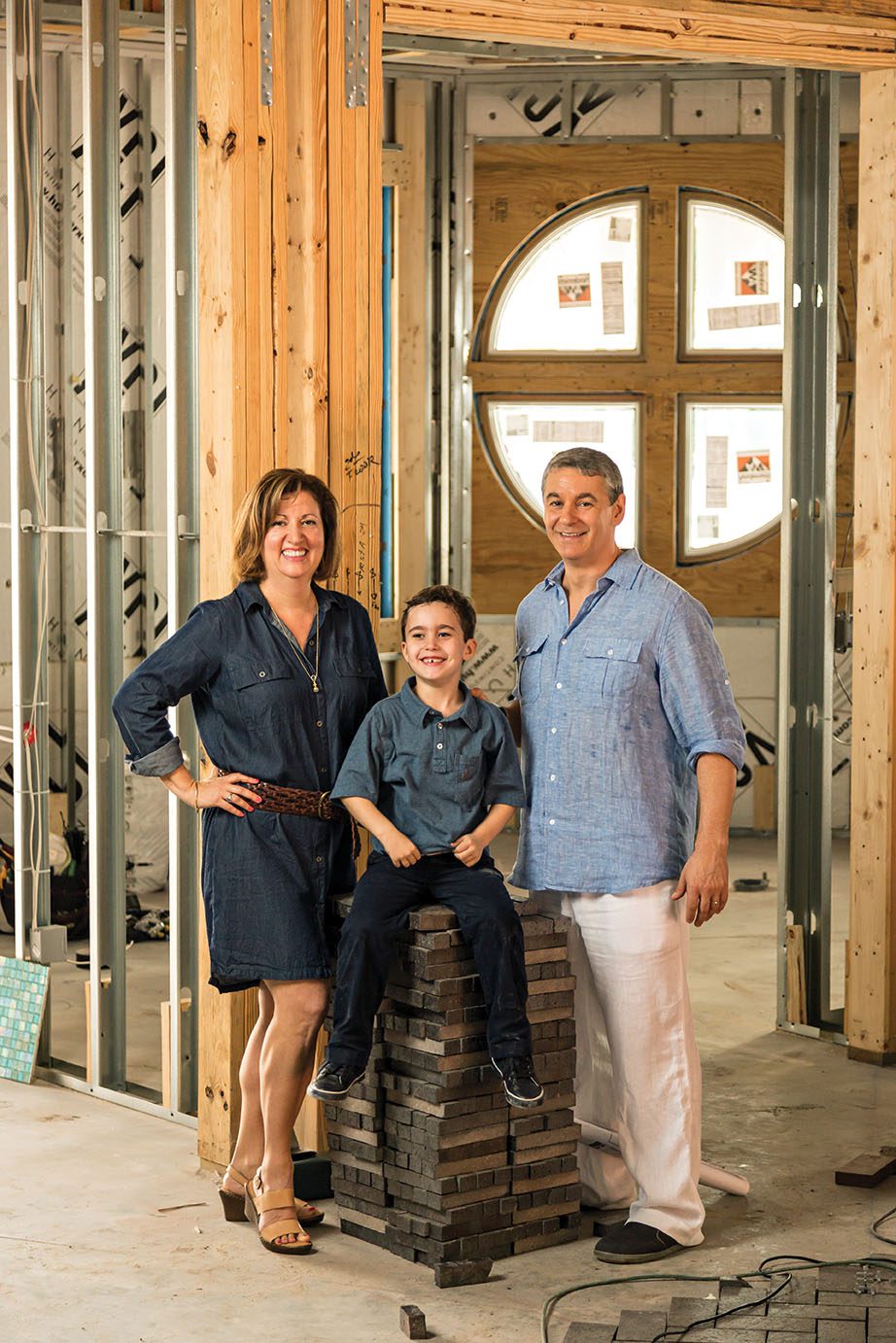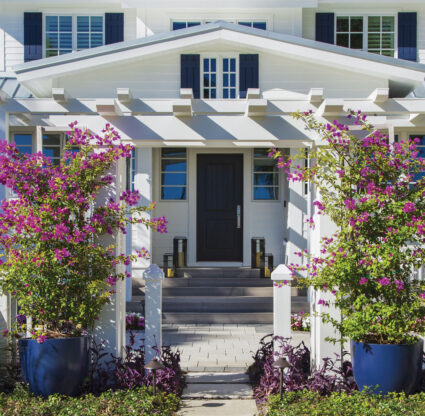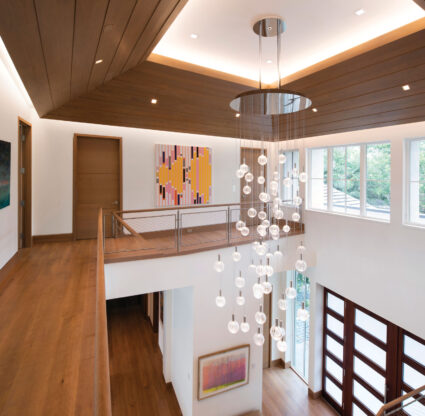It all began in the way of most great follies: with an offhand comment made by an unsuspecting husband to his equally unsuspecting wife.
“No, I don’t love our house,” my husband, Tom DeMarchi, said in December of 2014, “and I never will.” I had been fishing for compliments about our tall, light-filled seaside Naples home, and I looked up at him in genuine surprise. It had taken one year to build, and another year and a half to slog through the punch list. We had sacrificed a great deal for Project Beach House, but it was finished. Shouldn’t we be celebrating?
“You don’t love it?” I asked. “Not even the tiles on our staircase?” I’d labored over those coastal Moroccan beauties for months at Ann Sacks Tile, selecting custom colors and patterns for each riser.
 |
|
Architect Jon Kukk explains a process to Tolchin, interior designer Sydney Sorenson and Harwick Homes President Mark Smith. |
“Especially not the staircase,” Tom said. “Every night before I fall asleep, I picture our child plummeting down those steps.”
I sighed the sort of sigh that only a wife can sigh. I’d thought we were home, but clearly it was time to pack our bags.
I had only myself to blame. I’d pressured Tom into the purchase because of another offhand remark, this one made by our toddler Charlie’s pediatric pulmonologist. Charlie has cystic fibrosis, and when his doctor recommended we move closer to the sea for the fresh salt air, I practically drove straight from the medical complex to the real estate agent’s office.
When I brought him for his first look in 2012, Tom said, “It has no character.”
Tom failed to understand that “character” often translates into “toxic mold” in Southwest Florida. The house met all of our criteria: new construction, plenty of space, (barely) within our budget, near good schools, right across the street from the beach. Since I’m the classic “wife with the whim of iron,” we bought the house.
I never gave much thought to the fact that it was three stories tall, and thus basically a giant staircase with beds.
Fast-forward two years. Tom and I were both battle-weary from the trials of new construction, but Tom’s ghastly nighttime visions proved contagious. I didn’t want my husband to be unhappy in his own home, and I certainly didn’t want my child to be in danger. A mischievous thought arose: Would it be so terrible to have to return to Ann Sacks?
It seemed pretty crazy to do it all over again so soon, but crazy is how we roll.
Tom’s offhand remark set in motion a huge chain of events. “You’ve got to stop telling people that we’re moving again because of me,” he said.
“Why not?” I asked. “Isn’t it true?”
“Admit it,” Tom said. “This is all just an elaborate ruse to get you back to Ann Sacks.”
Sometimes it’s hard to be married to someone who knows me so well.
Our tall seaside home turned out to have been a phenomenal investment. Based on the comparables we received from our lovely and talented Realtor at Premier Sotheby’s on Broad Avenue South, Cameron Diaz-lookalike Heather Hobrock, our home was appreciating at the staggering rate of approximately 15 percent annually. (Show me that stock, please.)
We realized we could swap our home for a larger one just a block or two inland. By choosing a big leafy lot over a tiny beachy one, we could live more horizontally than vertically. I could get a large swimming pool for my morning workout. Charlie could have a tricked-out tree house. We could make Tom’s office a true man cave. And we could still marinate in salty air.
Operation Beach House was a failure. Could Operation Tree House be a success?
We quickly discovered there was precious little inventory from the southern end of Aqualane Shores clear up to the northern border of the Moorings. We realized new construction was the best choice for us … again. So we started to look for vacant lots, only to find that those, too, were in short supply.
We decided to buy a “tear-down,” an old home that we could raze. This time, we wouldn’t just be finishing an existing structure. This time, we’d be working with an architect.
“How much harder could it be to build from scratch?” I asked. Oh, the breathtaking naiveté!
One week before Christmas 2014, driven by my “whim of iron,” I located the perfect lot. It was in Coquina Sands, just a few blocks away from our current home. I was casing the neighborhood like a burglar when I spied a friendly looking retiree planting a tube of brochures in his front lawn.
The 1960s-era house had suffered too much water damage to renovate, but the .7-acre lot was obviously something special. As I walked the length of it, I had the strangest feeling I was walking back into my northern childhood. The foliage was different—sea grape, banyan, pine and mahogany trees as opposed to the dogwoods, crepe myrtles and oaks of my Maryland youth—but I was surrounded by some of the tallest old-growth trees I’d encountered in Southwest Florida. I knew instinctively that the place had known tire swings, block parties and happiness. When I returned with Tom to talk with the owners, a pair of jovial, kind-hearted Scandinavian missionaries who had raised their children in this idyllic setting, I began to wish they came with the purchase.
“Let’s give them whatever they’re asking,” I said to Tom that night before bed, my eyes glazed with new love.
“Please don’t speak during this negotiation,” Tom begged me. “Not a single word. Not even ‘Hello,’ or ‘Gesundheit’ if someone sneezes.”
On Christmas Day, Tom, Charlie and I walked over to sign an agreement. It was the best Christmas gift ever, but our then-5-year-old son seemed more interested in the pile of presents under Astrid and Pelle’s tree.
“Do we get to keep these?” Charlie asked, clutching a shiny beribboned box with both hands.
“I’m sorry, but those are for our grandchildren,” Pelle said. To make it up to Charlie, he started playing carols on his piano and accordion.
 |
|
Charlie reviews his plans for the tree house with Smith and Kukk. |
Our first step was to hire the best real estate attorney in Southwest Florida: Kevin Coleman of Coleman, Yovanovich and Koester. Kevin is the most caffeinated person I know and gives the impression of someone who should be working for the military.
“Sorry about the bad connection,” Kevin once said to me during a minor crisis. “The reception’s no good up here.” “Up here” turned out to be on a mountaintop in Whistler, Canada, where Kevin was hiking with his family. No matter what, he always takes my calls.
Our next move was to hire Jon Kukk of Kukk Architecture. I could tell you that we hired Jon because of the symmetry and aesthetic appeal of his portfolio. I could say it had something to do with his whip-smart Cornell-educated brain. But the truth is that when Jon walked through our beach home to assess what worked/didn’t work for us, he spied an Italo Calvino novel on Tom’s nightstand and quoted the author to us.
“It’s been a long time since I’ve read Invisible Cities,” he said, thus winning Tom’s loyalty forever. (Tom and I are both English professors at FGCU.)
We’d heard enough about Christian Andrea of Architectural Landscape Design to know we’d be foolish to consider anyone else. I took an instant liking to Christian, who has just the sort of quiet intelligence and peaceful demeanor you’d expect in someone who is on close personal terms with trees.
Our old builder’s meditative approach to our punch list should have kept him off our list of candidates, but he did build us a solid, appealing home, and we don’t like to hold a grudge. We interviewed him along with three other Naples builders.
Interviewing general contractors made me feel like the belle of a rough and tumble ball: It was equal parts flattering/worrisome to be the center of their attention. After all, new home construction in Naples involves some serious bank. In 2015 alone, builders pulled $543 million in new construction permits. How would these steel-toed-boot-wearing men take it when we took our business elsewhere?
I entered the project dreaming of the gray cedar shake architecture I’d come to love as a child during holidays on Cape Cod. We started with an architectural wish list 40 items long, including details like giant round windows and clerestory windows. Every builder said some version of the same thing: “You want an awful lot for $400 per square foot, but we should be able to get close.”
We decided to hire our old builder again, and for six months, during our selection process, Project Tree House became a grueling exercise in compromise run amok. Turns out that cedar shingles double the price of a home in Southwest Florida because you’ve essentially got to build two houses: a concrete block structure that will withstand hurricanes, and a wood frame for the shingles. The shingles were the first to go, closely followed by my beloved custom tiles—a bad omen if there ever were one. In the end, the old builder slashed our wish list to the bone, but he still came in 25 percent over budget. When it was suggested that we jettison our hardwood floors in favor of carpet and make do without a pool heater to “value engineer,” we parted ways.
“Have we miscalculated the finances?” I wondered. “We’re English majors, not mathematicians, so it wouldn’t be the first time.” Tom and I talked about selling the lot and abandoning Project Tree House. Then we thought of those tall, beautiful trees.
As one last hail Mary pass to rescue the project, we decided to call Mark Smith, the president of Harwick Homes. We hadn’t spoken in half a year.
“I hope we haven’t burned any bridges….” I began.
“Absolutely not,” Mark said. “I’m so glad that you called.”

We immediately saw that we should have hired Mark back in January when we interviewed him in his Bonita Springs offices. Bonita had seemed slightly too remote to us then; now, we saw that it kept Harwick grounded in reality. They might be building some exquisite, palatial homes in Port Royal and Old Naples, just like the other guys, but they hadn’t begun to assume that everyone could pay 25 percent over budget.
Mark quickly set about restoring most of the items on our wish list and adding some for good measure.
“Shouldn’t you have a Lutron lighting system?” he asked us.
“We wanted one!” we said.
Harwick came in 5 percent over budget, but we could stretch that far for a dynamite house.
It would not be an exaggeration to say that Harwick Homes rescued Project Tree House. After we signed with Mark and began poring over the architectural plans with him, our trust and appreciation grew exponentially. It wasn’t just about the money.
“Did you realize that Charlie’s bathroom window could be much larger than it’s drawn?” he said.
“It overlooks the outdoor AC units,” I explained, wrinkling my nose. Mark got the dimensions and figured out how to expand the window by several feet without exposing a marred view or breaking the bank. In eight years, when Charlie is shaving with plenty of sunlight, he’ll have Mark to thank. How many other builders would notice or care? That sort of moment has been replicated at least 25 times throughout our process. It’s not about driving up costs: It’s about puzzling our way to the smartest allocation of our funds.
Harwick’s project manager, Kathy Katasak, embodies a similar spirit. It took me 10 tries before I finally landed upon a shutter color (Kiwi by Benjamin Moore) that I’m confident I will still like in five years, but Kathy has never complained.
As much as I love interior design, I still need someone to rein me in when I’m trying to incorporate too many styles. Sydney Sorenson and I became friends back when I was furnishing the beach house. One of Ethan Allen’s in-house staff in Estero, she has a fabulous, innate sense of style, loads of tact, a great sense of humor and one of the world’s best raucous laughs. We share a love of coastal style, chardonnay, the show Portlandia and there’s nobody better to help you figure out how large the pendant lights over your kitchen island should be. I approached her about doing some consulting on an hourly basis and asked for her fee.
“Oh, just buy me lunch once in a while,” she said. “This will be fun.”
“I’m sure it will be, with you on board,” I said. Then I forced her to name a number so I could abuse her with lots of geometry tasks without guilt.
Ironically, the largest setback we encountered (besides having to change horses mid-race) had to do with an actual setback on our lot. The survey we commissioned back in January turned out to be faulty. Luckily, Harwick did its own survey before they poured our foundation and caught the error. Our house had to be resituated on our (slightly smaller) lot and redrawn. We were losing approximately 150 feet of living space, and our hard-won permit would need to be resubmitted. I was inclined to despair, but Kevin Coleman, Mark Smith and Jon Kukk worked together to minimize the damage.
“Can you imagine if we’d had to jackhammer the new foundation after some city inspection?” I asked Tom.
Tom fixed me with the sort of look that only a husband can give.
“Yes,” he said, with a long sigh. “Yes, I believe I can.”
Meanwhile, back at the beach house, Heather Hobrock commissioned gorgeous photos of our tiled staircase that Sotheby’s used in full-page ads for the company. When the Chinese economy started to monkey with our stock market, Tom and I began to chew our fingernails. What if we ended up with two expensive Naples homes? We began to sleep better when, 68 days after we list the home on MLS, we achieved a signed contract with a buyer.
Every morning before I drop Charlie at school, I take a slight detour past the new house. We’re both eager to see what changes we might spy from the day before. Workers have been on-site six days a week since construction began five months ago, so the changes have been rapid and exciting. I slow down and lower our windows. If Lee of Bassel Builders (a subcontractor) is working on our roof, we’ll shout “Hello” and he’ll give us a friendly wave, as will Preston Brown, our project supervisor.
“When can we move in?” Charlie asks me. “Will there be a tree house for me?” I make a note to start looking at tree house designs with Charlie.
“Any day now,” I say. “Just you wait and see.”
The Top Five Things We’ve Learned
1. Build your team before you build your house. Vet your general contractor, architect, landscape architect, interior designer and real estate lawyer. Imagine spending hundreds of hours in meetings with these folks. If you don’t get the warm fuzzies, run while you still can.
2. Be open about your budget with your general contractor. It’s not like going into a car dealership, where most people hide the real number. An honorable GC will help you determine the best way to allocate your funds. That said, you should still expect to go 10 percent over budget, as most people do. The architect and other key players may bill separately, the cost of concrete may double, and your tastes will inevitably be more expensive than you realize.
3. Specify as many details as possible about your new home. Research the costs in every category plus the builder’s mark-up (typically 15 percent), have input into every allowance category, and build realistic allowances into the contract, especially if you are using a bank loan. If your allowances are inadequate, you’ll be making up the difference out of your own pocket in the middle of construction. Ultimately, don’t sign any contract until it’s been blessed by your real estate attorney.
4. Don’t be a brand snob; instead, make use of great local artisans and companies. For example, Ruffino cabinetry is top-notch, and it’s made in Southwest Florida. That means you won’t need to worry about what may or may not be happening in some factory abroad.
5. Spring for an artist’s rendering of the home before you make exterior color selections. Ours cost $550 and was worth every penny. At first, we thought we wanted blue shutters and lots of bougainvillea; after seeing the picture, we realized green shutters and yellow hibiscus were more to our liking. The rendering helped ensure a good blend of colors in our exterior fixtures, roof, pavers, etc.
Plus, one bonus:
Expect problems and delays, and don’t get overwhelmed. The right team will help you get through (relatively) unscathed.





